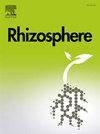Cover crops as a strategy for root rot management in common beans: Effects on crop performance and root microbial dynamics in a Cerrado soil
IF 3.4
3区 生物学
Q1 PLANT SCIENCES
引用次数: 0
Abstract
No-till farming is a key restoration technique that helps preserve soil health and productivity without expanding cultivated areas. Here, we investigate the influence of different cover crops on the performance and root microbial diversity of common beans in a Brazilian Cerrado soil. The study was conducted for five years on a commercial farm, with six treatments and three replicates. Treatments were evaluated yearly for yield and dry root rot severity (Fusarium spp.). Rhizospheric soil samples were analyzed for microbiome diversity using metataxonomics in the last year of the experiment. Oat and sunn hemp consistently performed better for severity, while a mix of cover crops, oat and palisade grass resulted in higher yields than fallow. Diversity metrics did not vary between treatments for both bacterial and fungal communities. Streptomyces was prominent in oat and sunn hemp, while Fusarium dominated the fungal community across treatments with a relative abundance of >35%. Characteristics prediction highlighted significant bacterial functions and fungal traits, with palisade grass showing distinct methanol oxidation and oat exhibiting diverse fungal endophytes, saprotrophs, and organic matter decomposers that may compete against Fusarium spp. Network analysis revealed variable co-occurrence patterns, with Fusarium spp. exhibiting different associations depending on the treatment. The network analysis also highlighted competing fungal genera that may guide biocontrol strategies. Mix, oat, and pearl millet were the cover crops favoring the highest number of genera negatively correlated with Fusarium spp. in the common bean rhizosphere. Future studies should explore the long-term effects and temporal dynamics of the common bean root microbiome.
求助全文
约1分钟内获得全文
求助全文
来源期刊

Rhizosphere
Agricultural and Biological Sciences-Agronomy and Crop Science
CiteScore
5.70
自引率
8.10%
发文量
155
审稿时长
29 days
期刊介绍:
Rhizosphere aims to advance the frontier of our understanding of plant-soil interactions. Rhizosphere is a multidisciplinary journal that publishes research on the interactions between plant roots, soil organisms, nutrients, and water. Except carbon fixation by photosynthesis, plants obtain all other elements primarily from soil through roots.
We are beginning to understand how communications at the rhizosphere, with soil organisms and other plant species, affect root exudates and nutrient uptake. This rapidly evolving subject utilizes molecular biology and genomic tools, food web or community structure manipulations, high performance liquid chromatography, isotopic analysis, diverse spectroscopic analytics, tomography and other microscopy, complex statistical and modeling tools.
 求助内容:
求助内容: 应助结果提醒方式:
应助结果提醒方式:


